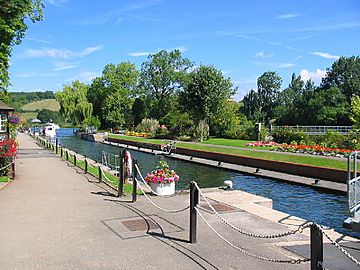Mapledurham Lock facts for kids

Mapledurham Lock on a fine August day
|
|
| Waterway | River Thames |
|---|---|
| County | Berkshire |
| Maintained by | Environment Agency |
| Operation | Hydraulic |
| First built | 1777 |
| Latest built | 1908 |
| Length | 61.69 m (202 ft 5 in) |
| Width | 6.42 m (21 ft 1 in) |
| Fall | 2.05 m (6 ft 9 in) |
| Above sea level | 127 ft (39 m) |
| Distance to Teddington Lock |
59 miles |
Mapledurham Lock is a special kind of gate system for boats, located on the River Thames in England. It's about 4 miles (6.4 km) upstream from the town of Reading. This lock helps boats travel along the river. The first lock here was built in 1777. The lock you see today was built in 1908. It works with a weir, which is like a small dam.
Contents
Where is Mapledurham Lock Located?
Even though it's called Mapledurham Lock, it's actually in a village called Purley-On-Thames. This village is in Berkshire, on the south side of the River Thames. The village of Mapledurham, which gives the lock its name, is on the other side of the river in Oxfordshire. You can reach the lock from Purley village by following Mapledurham Drive. The weir stretches across the river, connecting both counties.
The Weir and Its Purpose
The weir at Mapledurham runs from the lock island in a long curve across the river. You cannot walk across the weir. To get between the two villages (Purley and Mapledurham) without a boat, you have to take a long trip through Reading or Pangbourne.
The weir is important because it creates a strong flow of water. This water power still helps to run the Mapledurham Watermill. This mill is on the opposite side of the river from the lock. The Mapledurham weir is also the furthest upstream on the Thames that has a special salmon ladder. This ladder helps salmon swim upstream to lay their eggs.
A Look Back: History of Mapledurham Lock
The Mapledurham mill has a very long history, going all the way back to the Domesday Book. This book was a huge survey of England made in 1086. The weir was probably connected to the mill even then. The first written mention of the weir is from the time of King Edward I. The mill was part of the Mapledurham House property. The Blount family, who owned the house, always had an interest in the weir.
Before the current lock, there was a "flash lock" at the weir. A flash lock was a simple barrier that could be opened quickly to let boats through with a rush of water. However, boats stopped using this flash lock when the modern "pound lock" opened in 1777. This new lock was built on the Purley side of the river. It was meant to be called Purley Lock, but people kept using the old name, Mapledurham Lock.
In 1816, a small house was built for the lock-keeper. During the 1800s, there were some disagreements between the lock-keeper, William Sheppard, and the Blount family. But even with the Blount family's complaints, Sheppard stayed in his job for 54 years! He retired when he was 79 years old. A new and much bigger lock was built next to the old one in 1908.
Mapledurham Mill is still working today, across the river from the lock. This makes Mapledurham the only place on the Thames where a lock, weir, and mill all work together. In the past, there were often arguments between mill owners and boat users. But now, both the mill and the river navigation are mostly for tourists, so these conflicts don't happen anymore.
Exploring the River Above the Lock
The river above Mapledurham Lock flows through beautiful open countryside almost all the way to Pangbourne. The writer Robert Gibbings described the views here in 1939 as so amazing "they might have dropped from the gold frames of the Royal Academy".
As you travel upstream from Mapledurham, you can see Hardwick House on the north side of the river. Further along, Pangbourne Meadows are on the south side. These meadows are owned by the National Trust, a charity that protects important places.
The Thames Path is a long-distance walking trail that follows the River Thames. It runs along the southern bank up to Whitchurch Bridge. This bridge crosses the river between Pangbourne and Whitchurch. It is a toll bridge, but pedestrians can cross for free. Between the bridge and Whitchurch Lock, a smaller river called the River Pang joins the Thames from the south.
The famous artist E. H. Shepard, who drew the pictures for the book The Wind in the Willows, made many drawings in this area. Some people say that Toad Hall, a famous place in the book, might have been inspired by either Mapledurham House or Hardwick House.
Images for kids





